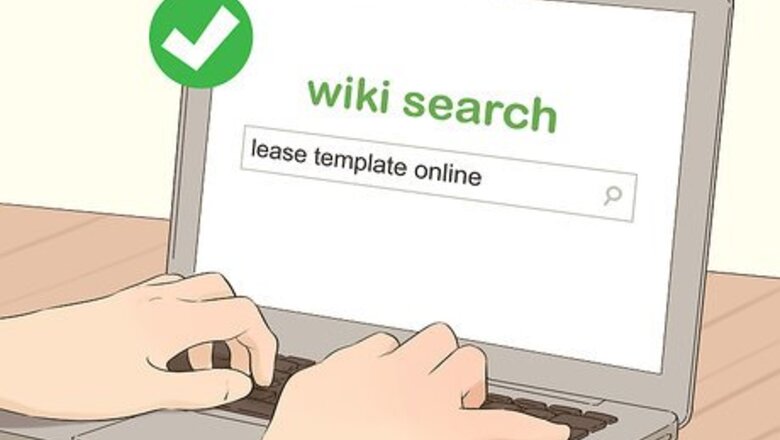
views
X
Research source
Formatting Your Document

Look online for free templates. Government agencies, legal assistance companies, and nonprofit organizations have lease agreement templates available that you can use to write your lease. Even if you don't end up using the template verbatim, it's easier than starting from scratch. Most templates are designed based on the laws in a particular area. Make sure the template would be valid and enforceable where your property is located. You can add location names to narrow your search and ensure you're getting a template you can use. Many government agencies have "model agreements" available that you can use. These agreements are designed to comply with the law in that area.
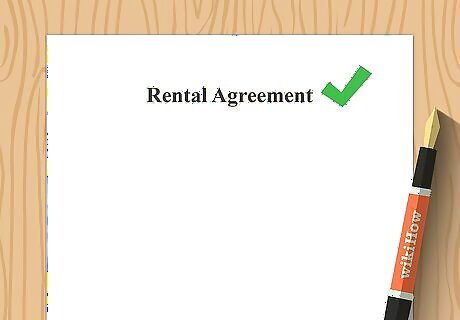
Create a title for the document. You can get as specific as you want with your title, but generally, it's best to keep it simple. "Lease" will suffice, or you could use "Rental Agreement" or "Lease Agreement." If you're using a model agreement produced by a government agency, check to see if you have to use the title provided, or if you can change it to suit your needs.

Draft headings for the sections of the lease. If you organize your lease under specific headings, information is easy for both you and your tenant to find without having to read the entire document. Include headings such as "property," "term," "rent," and "deposit." You may also have headings for "tenant's responsibilities" and "landlord's duties." Use bold for your headings so that they're easy to see in the document. You might also center them on their own lines.Tip: The use of bold and italic font can also be used to draw attention to specific details in the lease itself, such as the amount of rent. However, use them sparingly or your document will look cluttered and your formatting may lead to confusion.
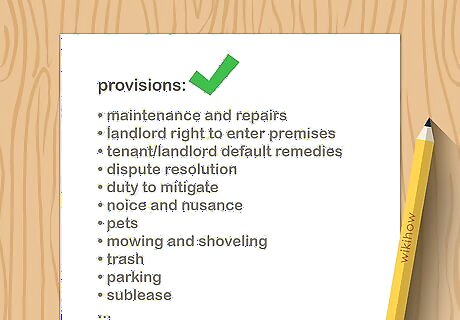
Outline the provisions you plan to include. Take a moment to write a list of the key issues you want your lease to address. Then you can easily organize them under the section headings if you're not using a template. If your section headings aren't sufficient, you may need to add new ones to cover the provisions you need. If you're using a template, read over the template and compare it to your list. If you have anything included on your list that isn't covered by the template, you may need to write a new clause to cover it.
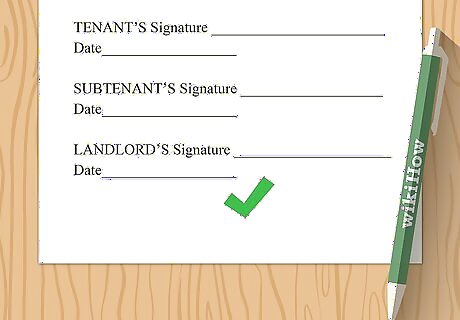
Add space for signatures at the end. A lease must be signed by you and your tenant to be legally valid. Additional witnesses typically aren't required, and you usually don't have to sign the document in front of a notary (although you can if you want for added security). If you're creating a form to use multiple times, you may want to simply type "tenant" and "landlord" under the lines. However, include specific names for a single-use document.

Check local landlord/tenant law. Your lease agreement, as well as the rental property itself, must comply with all applicable laws. In addition to any national laws, there may also be local ordinances that apply depending on the location of the property. Most provisions that violate local law would simply be unenforceable in court. However, that would mean that whatever issue that provision was supposed to cover wouldn't be covered under the lease. If an important provision, such as the amount of the rent, is unenforceable, it may render the entire lease illegal and unenforceable. Pay particular attention to laws governing deposits, your responsibilities as a landlord, and the amount of rent you can charge.
Covering Standard Provisions
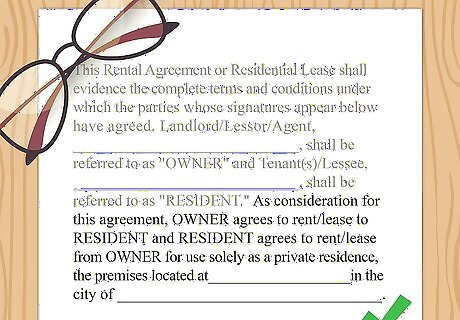
Identify the property covered by the lease. Provide the address and street number of the property or individual unit you're renting out. It may also help to include a description of the property, particularly if that description affects ownership or legal rights. For example, if you're renting a condominium, you typically should identify it as a condo. Condominium ownership rights are different from rights to other property. If there are zoning restrictions that might impact the rental or your tenant's usage of the property, include those here as well.
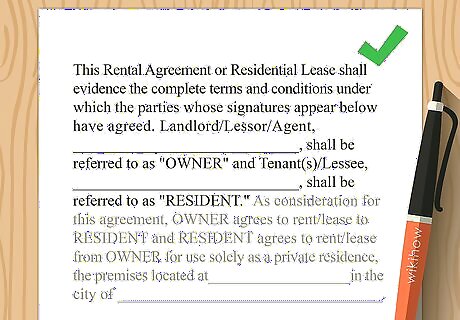
List the parties to the agreement. After describing the property that is the subject of the lease, provide your name and the name of the person who will be renting the property from you. If you've organized your rental business as a corporation, LLC, or other business entity, provide the name of the business rather than your own name. If you're creating a form that you intend to use multiple times, you can leave a blank for the names and fill them in later depending on the circumstances.Tip: In this and other provisions, avoid using too much legalese. Instead, use plain, straightforward language that is easy to understand. Instead of using legal titles such as "lessor" and "lessee," for example (which many people struggle to keep straight), simply refer to "landlord" or "owner" and "tenant" or "resident."

Set the length of time the agreement will be in effect. Residential leases typically last for a year, although they may be as short as 3 or 4 months or even last for several years. Provide the duration of the lease as well as the specific dates during which it will be in effect. Your jurisdiction may have laws specifying a minimum or maximum duration for residential leases. Make sure the length of your agreement is in compliance with local laws.
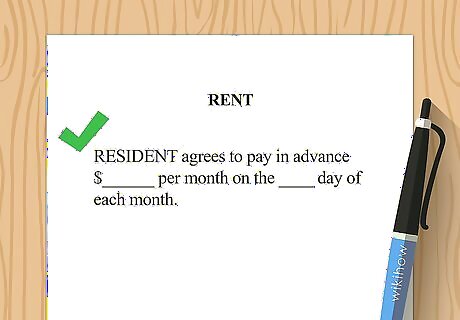
Specify the rent to be paid and when it is due. Provide the amount of rent and the date on which it is due. Most leases include a grace period of a week or so for the tenant to pay the rent – however, a grace period typically isn't legally required. You might also include acceptable methods of payment. Some cities have rent control ordinances that determine the maximum amount of rent you can charge for certain types of residences.

State the amount of any deposits or fees. Deposits must be used to repair damage to the rental unit or returned to the tenant at the end of the lease. The deposit money you take must be protected, usually by keeping it in an escrow account that earns interest. Specify when any unused deposit will be returned to the tenant after they've vacated the property. Under some laws, you must return any unused deposit within a specific period of time, typically 30 to 90 days after the tenant vacates the property. Some places have laws that limit the amount of money you can charge as a deposit. Check the law that applies to your property to make sure you're not requiring a larger deposit than is allowed. Typically, 1 or 2 months' rent is considered a reasonable deposit amount.
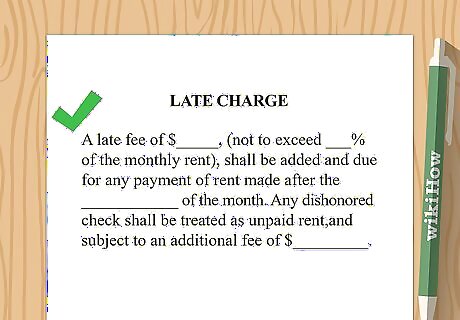
Describe the consequences of late payment. Having specified the rent, list late fees and penalties in the event the tenant doesn't pay the rent on time. Include notices you'll send to the tenant regarding late rent, and when you will file for eviction for unpaid rent. This portion of the lease is heavily dependent on eviction law in your jurisdiction. In many places, the law states specifically how many notices you must give the tenant before you can begin eviction proceedings, and how much time you must give them to pay.

Include provisions for renewing or ending the relationship. You may want to set the lease to automatically renew unless the tenant gives you advance notice that they are moving out. On the other hand, you may require your tenant to give you advance notice that they want to renew. Reserve the power not to renew the lease, unless a local ordinance forbids it. Include a clause that specifically states you reserve the right not to renew the lease for any reason, or no reason at all. Notice of 30 days is typically sufficient to end or renew a 1-year lease. If the lease is longer, you may want to require more time. For example, a 2-year lease might require 60 days notice.
Adding Specific Terms and Conditions
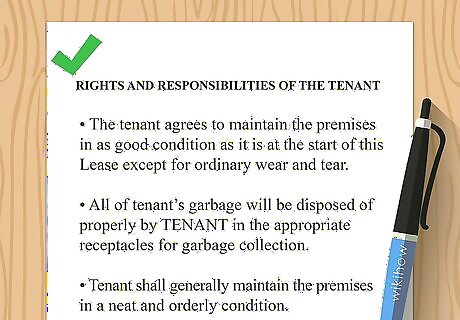
Outline the rights and responsibilities of the tenant. Tenants typically have the responsibility to not damage or destroy the property while living in it, to notify you promptly of any maintenance issues that require your attention, and to obey all local laws while occupying your property. Include any limitations regarding what the tenant can do to the outside of the property as well, such as planting a garden, putting up a satellite, or hanging decorations during holidays. Explain any temporary changes that the tenant can make to the property, such as painting. Typically, tenants are allowed to make these sorts of changes as long as they undo them when they move out and leave the property the same as it was when they moved in. Many leases require the tenant to maintain renter's insurance to protect their belongings in the event of theft, fire, or other issues.
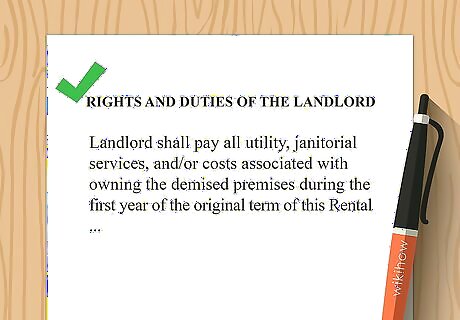
List the rights and duties of the landlord. As the landlord, you have duties set forth in your local landlord/tenant law. Generally, you are expected to maintain the property in livable condition and make any repairs promptly. You typically have the right to enter and inspect the property at any time, although you usually must give the tenant notice beforehand (24 hours notice is usually sufficient). Some laws may specify that you can only enter the property during reasonable hours unless there is a maintenance emergency.

Lay out the procedure for handling lease violations. If the tenant fails to follow through with their responsibilities under the lease, they are in violation. Similarly, you would be in violation of the lease if you didn't fulfill your duties as a landlord. The procedures for handling a lease violation typically vary depending on whether the landlord or the tenant is in violation. In most situations, a written complaint or notice is required before either you or the tenant can take any remedial measures, such as filing a lawsuit or beginning eviction proceedings. This procedure relies heavily on your local law and varies widely in different areas. Even if you used a lease in one place, don't assume it will be legit if you rent out property in another jurisdiction.

Include details regarding any amenities or privileges. If the rental includes access to a pool or gym, describe these amenities in the lease and explain when they are available and how they can be used. Specify whether the tenant can have guests, and how many guests they can have. If you are allowing the tenant to have pets, specify the types of pets that are appropriate and whether you're charging a pet fee, additional deposit, or monthly "pet rent." If the property is in an area where parking is limited or assigned, state the number of parking spaces the tenant is entitled to and whether there are any passes available for guests.Tip: There is no such thing as a "non-refundable deposit." If you require an additional amount for pets that you don't intend to refund to the tenant after repairing any damages to the property, it is a fee, not a deposit.

Have an attorney review your lease. Before you have a tenant sign a lease, get legal advice on whether the terms are enforceable. The attorney might also let you know some other terms that you can include, or provide you with language that will help you in the event you have to evict the tenant. Many attorneys will offer a free initial consultation, but don't expect them to review your lease for free. Contact several real estate attorneys to find out their rates and choose the one that best meets your needs and your budget. The attorney typically will suggest that you add a number of provisions commonly called "boilerplate." These provisions are included in most standard lease templates. They simply govern the choice of law and how the agreement should be interpreted if you and your tenant end up in court.




















Comments
0 comment